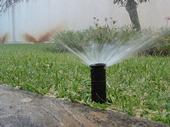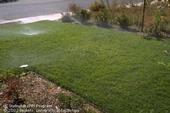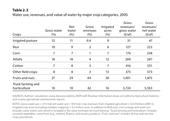
Californians cut water use in July by 31.3 percent compared to the same month in 2013, exceeding Gov. Brown's 25 percent mandate for the second consecutive month, the California State Water Control Board reported last week.
With dry conditions forecast to continue through November, UC Agriculture and Natural Resources developed a series of videos with tips for enhancing conservation efforts in outdoor landscapes. The second video in the series, which debuts today, advises homeowners to limit outdoor irrigation to the early morning hours.
In the morning, says host

To conserve water and meet California's new water-use restrictions, one place to start is literally in one's own backyard. More than half of all household water use is typically used outdoors on landscape, according to University of California Agriculture and Natural Resources experts.
For homeowners, there are six key things to do to conserve landscape water, says Karrie Reid, UC ANR Cooperative Extension advisor, in San Joaquin County. Reid gives the following six tips:
- Tune up your irrigation system right away. When water is efficiently and accurately applied, less water is needed to keep plants healthy. Spray heads can get knocked out...
- Author: Jeannette E. Warnert

Rain in December raised hopes for an end to the California drought, but storms have stayed away since the New Year began. January 2015 is shaping up to be the driest January since officials began keeping records 137 years ago, according to the National Weather Service.
California's continuing water crisis is leading to decreased and more variable water supplies for San Joaquin Valley farmers, and the region's forage production sector is being hit particularly hard.
“Corn silage and alfalfa have traditionally used lots of water and current and future water restrictions are forcing many farmers to rethink their forage production strategies,” said
- Author: Rebecca Miller-Cripps

The Water Conservation Act of 2009, also referred to as Senate Bill x7-7 or “20 by 2020,” mandates that California reduce urban per capita water use by 20 percent by the year 2020. It also requires all water suppliers to increase water use efficiency.
It’s estimated that 50 percent of California’s residential water is used outdoors — to water lawns, ornamental plantings and vegetable gardens, and in swimming pools. Our water use practices can always become more efficient.
To help us become more aware of our watering practices, July is designated as Smart Irrigation Month by the national
- Posted By: Trina Wood
- Written by: Jay Lund, Ellen Hanak, Richard Howitt, Ariel Dinar, Brian Gray, Jeffrey Mount, Peter Moyle, Barton “Buzz” Thompson

With this latest set of storms replenishing California’s snowpack and water levels in reservoirs, rivers and streams, it may be hard to think about water conservation issues. But this is a still a semi-arid state, so it is always prudent to prepare for droughts.
So where can we save the most water? Farming in California depends on irrigation, so agriculture seems the largest potential source for cost-effective water savings in the state. Although agriculture’s share has been declining, it still accounts for roughly 75 percent of all human water use, compared to 25 percent for urban uses.
The recent book, Managing California’s Water: From Conflict to...



